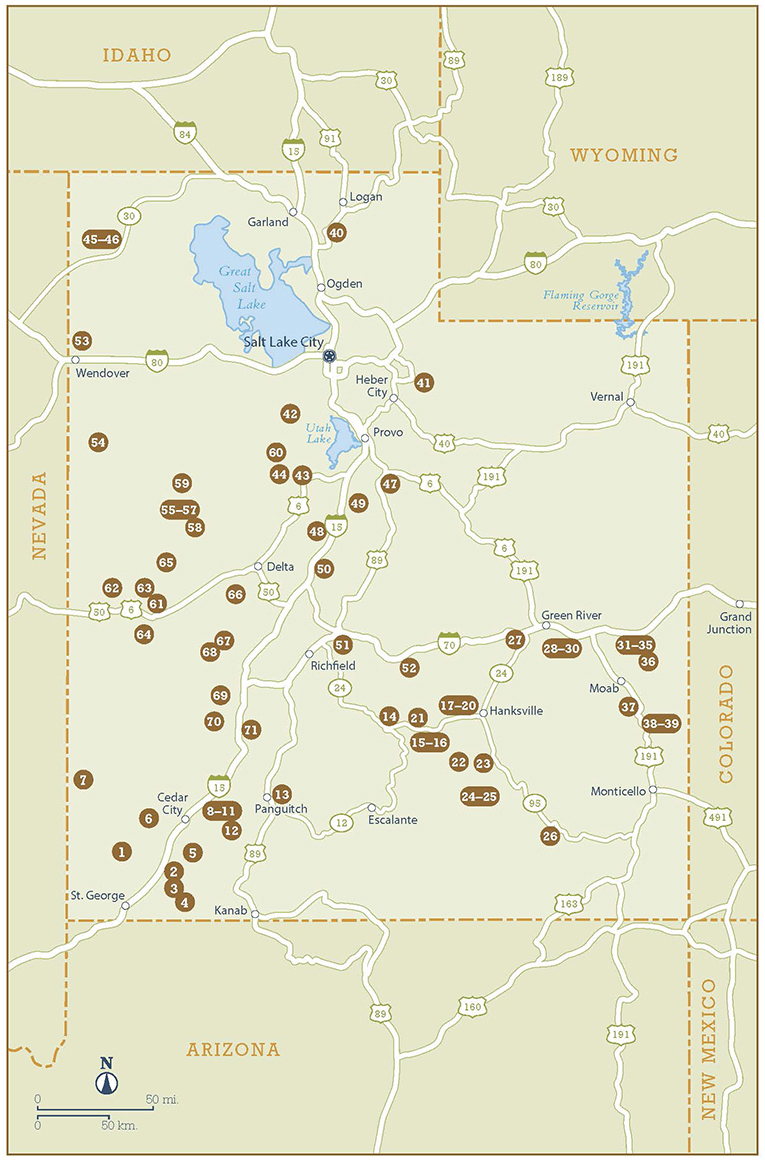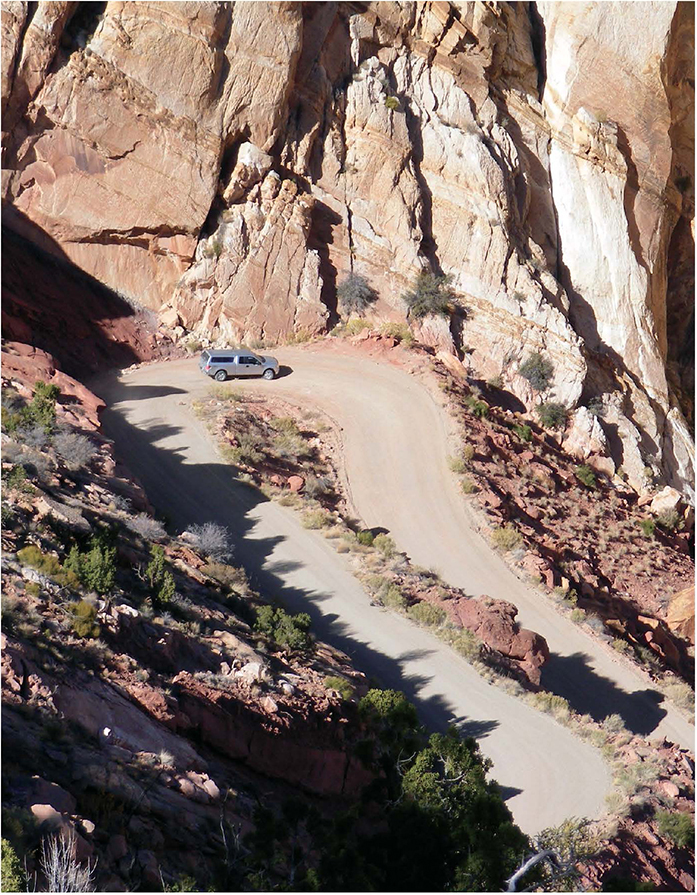William A. Kappele has been rockhounding across the West for more than forty years. His other books include Rockhounding Nevada and Rockhounding Colorado.
Gary Warren was born and raised in Clearfield, Utah. He and his wife eventually settled in Brigham City, Utah. They have four children, fifteen grandchildren, and three great-grandchildren. Gary has been a member of the Cache Rock and Gem Club, located in Logan, Utah, for ten years, eight of which he served as president. He enjoys sharing his love of rockhounding with children through school lectures and after-school group demonstrations and activities. The club has also incorporated a Junior Rockhounding program. Recently retired, Gary has more time to pursue his passions, traveling and rockhounding throughout Utah.
FALCON GUIDES
An imprint of The Rowman & Littlefield Publishing Group, Inc.
4501 Forbes Blvd., Ste. 200
Lanham, MD 20706
www.rowman.com
Falcon and FalconGuides are registered trademarks and Make Adventure Your Story is a trademark of The Rowman & Littlefield Publishing Group, Inc.
Distributed by NATIONAL BOOK NETWORK
Copyright 1996 The Rowman & Littlefield Publishing Group, Inc.
A previous edition of this book was published by Falcon Publishing, Inc., in 2014. This FalconGuide edition 2020
Photos by Gary Warren and his wife, Sally Warren, unless otherwise noted Maps by Melissa Baker, The Rowman & Littlefield Publishing Group, Inc.
All rights reserved. No part of this book may be reproduced in any form or by any electronic or mechanical means, including information storage and retrieval systems, without written permission from the publisher, except by a reviewer who may quote passages in a review.
British Library Cataloguing in Publication Information available
Library of Congress Cataloging-in-Publication Data available
ISBN 978-1-4930-4596-9 (paperback)
ISBN 978-1-4930-4597-6 (e-book)
 The paper used in this publication meets the minimum requirements of American National Standard for Information SciencesPermanence of Paper for Printed Library Materials, ANSI/NISO Z39.48-1992.
The paper used in this publication meets the minimum requirements of American National Standard for Information SciencesPermanence of Paper for Printed Library Materials, ANSI/NISO Z39.48-1992.
The author and The Rowman & Littlefield Publishing Group, Inc., assume no liability for accidents happening to, or injuries sustained by, readers who engage in the activities described in this book.
CONTENTS
Guide
I want to start by thanking the many people who contributed to this book and especially to William Kappele, without whose many hours and years of dedication this book would not have been possible. His directions were still good in finding the many sites that are described in this book. I was able to use his directions to take the GPS coordinates that have been added to the book. I want to say a big thank-you to the many friends and members of rock clubs in Utah who answered my many questions. Another big thank-you goes out to David and Kathy Farnsworth, who made the many trips with my wife, Sally, and me to get the GPS readings and to verify that material can still be found at the various sites in this book. They all have a love for the outdoors and enjoy rockhounding almost as much as I do.
Finally, I give my deepest thanks to my wife, Sally, who visited every site in this book with me and kept me on track, writing down the GPS readings and altitudes. Without her help I would have been driving around in the desert wondering where these sites were. She kept me on the right roads and verified mileage and distance. She also made sure I had photos of the various sites we visited and kept track of the log for the photos. We covered more than 4,000 miles researching and revising this book and re-photographing the sites that are featured here.
In 2019 they asked me again to revise and check over what has been in this book. I have added two new sites along with photographs. I have added new information to the Forest Service subsection on page 16 as their rules have changed since this book was revised in 2013, and in the back I have added a new section, Tools of the Trade, so that you can make sure you have the tools you need with you to go out and find your treasures. I hope that you enjoy this book and use it to help find your treasures in Utah.
Watch for hairpin turns on your way to Boulder, Utah, from Bullfrog Marina.
A nyone who has followed the rockhounding hobby for more than a few years has undoubtedly encountered the two most common types of guidebooks. First is the type that simply lists the material to be found, gives brief directions to the sites, and provides a map that may or may not be accurate.
The second type is more a treasure house of adjectives than a guidebook. Although the material to be found there may look as interesting as a piece of broken sidewalk, it will invariably be described as containing fiery reds, deep, rich purples, breathtaking oranges, and on and on.
Many rockhounds (including yours truly) have driven down miles of dirt roads and hiked over hills and through valleys only to be disappointed because the enthusiasm of the guidebooks author outdid the actual beauty of the find. We will not so mislead you in this book. If we are describing a site where red agate can be found, we will call it simply red agate, even if we might think it is fiery. You will have to be the judge, since beauty certainly is in the eye of the beholder. I have tried to verify all the sites to make sure that material is still available as of 2019, but it is up to you as to whether it is good enough for a cabochon or just a garden rock.
Another problem with some guidebooks is that they list old sites that are no longer productive. Some, in fact, have been rockhounded into oblivion and would not yield enough material for a cabochon if you used heavy equipment. This is not to say that all old sites are not worth visiting, however. Many still provide worthwhile cutting material or mineral samples, but it is not just a matter of leaning out the car window and picking them up. We have listed some of these sites, but we also tell you just how hard and long you may expect to work for your prizes.
All the sites in this book have been carefully checked as to accessibility. For example, we will not send you to a site that is part of a national monument. Grand StaircaseEscalante National Monument falls into this category. When this guide was first published, there were several sites at Grand StaircaseEscalante where rockhounds could explore and collect materials. Under current regulations, you can no longer collect any material from national monuments. I have removed these sites from this edition. We have also been extremely careful to indicate when a site is on private land. Farmers and ranchers are generally willing to let you collect on their property if it will not disrupt their activities, but you must always ask first. Just because there is no posting does not mean that collecting is allowed.
It is also important to understand that all sites, particularly mine sites, are subject to both fluctuations in mineral prices and the whims of their owners. One day a mine may look as though no one had been near it in a hundred years, but within a very short time, it could be reopened and working. If the trip to a listed site is a long one, be sure to check the collecting status locally before starting out Youll save a lot of time and effort.




 The paper used in this publication meets the minimum requirements of American National Standard for Information SciencesPermanence of Paper for Printed Library Materials, ANSI/NISO Z39.48-1992.
The paper used in this publication meets the minimum requirements of American National Standard for Information SciencesPermanence of Paper for Printed Library Materials, ANSI/NISO Z39.48-1992.
